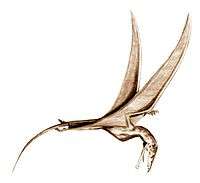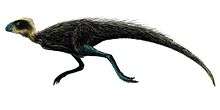Sacisaurus
| Sacisaurus Temporal range: Late Triassic, Carnian–Norian | |
|---|---|
| Scientific classification | |
| Kingdom: | Animalia |
| Phylum: | Chordata |
| Class: | Reptilia |
| Clade: | Dinosauromorpha |
| Clade: | Dinosauriformes |
| Clade: | †Silesauridae |
| Genus: | †Sacisaurus Ferigolo & Langer, 2006 |
| Species | |
| |
Sacisaurus is a dinosauriform from the Late Triassic (Carnian to Norian) Caturrita Formation of southern Brazil.[1] The scientific name refers to the city where the Sacisaurus was found, Agudo in the Rio Grande do Sul state and to Saci, a famous one-legged elf from Brazilian mythology, because the fossil skeleton has been found missing a leg. It was discovered in the geopark of Paleorrota.

Characteristics
Sacisaurus was 1.5 meters (5 ft) long and 70 centimeters (2.3 ft) high. Its long and strong legs indicate that it was a fast animal. According to Jorge Ferigolo, paleontologist of Zoobothanic Foundation of Rio Grande do Sul state, the biggest teeth of the genus were 3 millimeters (1/12 in) long.
The well-preserved jaw indicates that Sacisaurus was an herbivore, and there is a process at the tip that resembles the ornithischian predentary bone. Further research will attempt to define if Sacisaurus was the oldest ornithischian dinosaur. Through the cladistic analysis of some of its morphological particularities, its closest relative may be Diodorus.[2]
History
Sacisaurus was discovered in 2001 in the small municipality of Agudo, in the countryside of Rio Grande do Sul state. Through 50 bones, scientists could assemble the skeleton and speculate on how it might have lived. The fossil was presented for the first time in the 2nd Latin American Congress of Vertebrate Paleonthology in 2005.
After the work of Brazilian scientists, the announcement of the discovery of the new species was made on November 1, 2006 at the University of São Paulo, Ribeirão Preto, where the bones were identified and the paper was published in the British scientific journal Historical Biology: A Journal of Paleobiology on October 30, 2006.[1]
The discovery helped scientists to study the feeding habits of dinosaurs and their close relatives, since it is one of the oldest ever found.
References
- 1 2 Ferigolo, J.; Langer, M.C. (2006). "A Late Triassic dinosauriform from south Brazil and the origin of the ornithischian predentary bone" (PDF). Historical Biology. 19 (1): 1–11. doi:10.1080/08912960600845767.
- ↑ Christian F. Kammerer, Sterling J. Nesbitt, and Neil H. Shubin (2011) The first basal dinosauriform (Silesauridae) from the Late Triassic of Morocco. Acta Palaeontologica Polonica (in press) doi:10.4202/app.2011.0015
External links
- Jornal Hoje - Sacissauro é apresentado ao mundo
- Site oficial de Agudo - Fósseis de dinossauro foram encontrados em Agudo
- ecoelefante - Novo dinossauro brasileiro
- Folha online - Brasil "ganha" dinossauro de 220 milhões de anos
- Dinosaurs of Rio grande do Sul.



